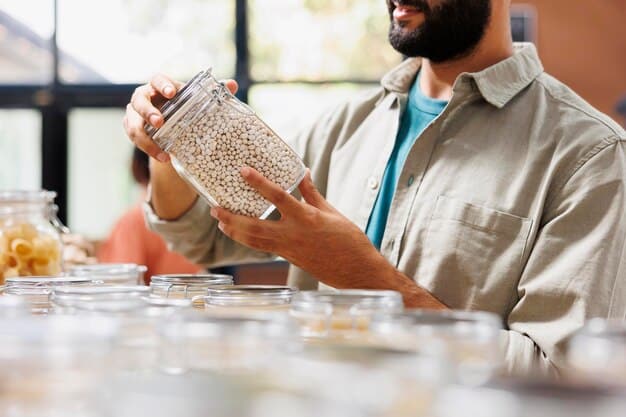Budget Shopping: Eco-Friendly Products That Save Money

Budget shopping for sustainable living involves finding environmentally friendly products that are affordable, helping you reduce your carbon footprint without exceeding your budget, and contributing to a more sustainable lifestyle.
Embarking on a sustainable lifestyle doesn’t have to drain your bank account. In fact, with budget shopping for sustainable living, you can find eco-friendly products that not only help the planet but also save you money in the long run. Let’s explore how.
Understanding Budget Shopping for Sustainable Living
Sustainable living is often associated with expensive, high-end products, but that’s a misconception. Budget shopping for sustainable living is about making smart, eco-conscious choices without overspending. It’s about finding value and longevity in what you buy, leading to both environmental and financial benefits.
This approach involves researching affordable alternatives, looking for discounts and sales, and prioritizing products that are durable and reusable. By adopting these habits, you can embrace a greener lifestyle without breaking the bank.
Why is Sustainable Living Important?
Sustainable living is crucial for preserving our planet for future generations. It involves minimizing waste, conserving resources, and reducing our carbon footprint. Here are a few key reasons why it matters:
- Environmental Conservation: Sustainable practices help protect natural habitats and biodiversity.
- Resource Management: By using resources responsibly, we ensure they are available for future use.
- Health Benefits: Many eco-friendly products are also safer for your health, reducing exposure to harmful chemicals.
Transitioning to sustainable living doesn’t need to be an overnight transformation. Small, conscious steps can make a significant impact, aligning your lifestyle with environmental values while staying within your budget.
Finding Affordable Eco-Friendly Products
One of the biggest challenges in adopting a sustainable lifestyle is the perceived cost. However, many affordable eco-friendly options are available. Knowing where to look and what to prioritize can make a big difference.
From reusable household items to energy-efficient products, making eco-conscious choices without compromising your budget is entirely possible. The key is to be resourceful, patient, and informed.

Reusable Household Items
Investing in reusable household items is a great way to reduce waste and save money over time. Here are some essential swaps:
- Reusable Shopping Bags: Keep reusable bags in your car or by the door to avoid using plastic bags at the store.
- Reusable Water Bottles: Opt for a durable water bottle instead of buying bottled water.
- Reusable Food Storage Containers: Use glass or BPA-free plastic containers for storing leftovers and packing lunches.
These swaps not only minimize environmental impact but also reduce the recurring cost of disposable items. They’re an easy win for your wallet and the planet.
DIY Eco-Friendly Solutions for the Home
Creating your own eco-friendly solutions can be both cost-effective and sustainable. DIY projects allow you to control the ingredients and reduce packaging waste. From cleaning supplies to personal care products, many recipes are simple and use common household items.
Embarking on DIY solutions empowers you to reduce your reliance on store-bought products and contributes to a more self-sufficient and eco-conscious lifestyle.
Homemade Cleaning Supplies
Commercial cleaning products often contain harsh chemicals that can be harmful to your health and the environment. Making your own cleaning supplies is a simple and effective alternative. Here are a few basic recipes:
- All-Purpose Cleaner: Mix equal parts white vinegar and water in a spray bottle.
- Glass Cleaner: Dilute white vinegar with water and spray on glass surfaces.
- Laundry Detergent: Combine washing soda, borax, and grated castile soap for a natural laundry solution.
These DIY cleaners are not only budget-friendly but also free from harmful chemicals, making your home a healthier place to live.
Sustainable Fashion on a Budget
The fashion industry is a significant contributor to environmental pollution. Fast fashion trends lead to excessive waste and resource depletion. However, sustainable fashion doesn’t have to be expensive. By adopting mindful shopping habits, you can build a wardrobe that’s both stylish and eco-friendly.
Exploring thrift stores, buying secondhand, and choosing durable, timeless pieces are all strategies that align your style with your values and budget.

Thrifting and Secondhand Shopping
Thrift stores and consignment shops are great places to find unique and affordable clothing. You can discover high-quality items at a fraction of the retail price.
Secondhand shopping reduces the demand for new clothing production, minimizing waste and conserving resources. It’s a sustainable and budget-friendly way to refresh your wardrobe.
Choosing Durable and Timeless Pieces
Investing in durable and timeless pieces is another key strategy for sustainable fashion. Opt for clothing made from high-quality, natural materials that will last for years. Here are some tips:
- Look for Durable Fabrics: Choose materials like organic cotton, linen, and hemp.
- Consider Versatility: Select pieces that can be mixed and matched to create multiple outfits.
- Avoid Fast Fashion Trends: Stick to classic styles that will remain in vogue for a long time.
By focusing on quality over quantity, you can build a sustainable wardrobe that reflects your personal style and minimizes your environmental impact.
Energy and Water Conservation Tips
Conserving energy and water is crucial for sustainable living. These practices not only reduce your environmental footprint but also lower your utility bills. Simple changes in your daily habits can make a significant difference.
Adopting energy-efficient appliances, reducing water consumption, and making small lifestyle adjustments can collectively create a substantial positive impact.
Energy-Efficient Appliances
When it’s time to replace your appliances, opt for energy-efficient models. Look for appliances with the Energy Star label, as they meet strict energy efficiency guidelines.
Energy-efficient appliances consume less electricity, saving you money on your utility bills while reducing your carbon footprint. This is a smart investment for both your wallet and the environment.
Reducing Water Consumption
Conserving water is another important aspect of sustainable living. Here are some simple ways to reduce your water consumption:
- Fix Leaks: Repair leaky faucets and toilets to prevent water waste.
- Take Shorter Showers: Reduce your shower time to conserve water.
- Use a Low-Flow Showerhead: Install a low-flow showerhead to reduce water usage without sacrificing water pressure.
These small changes can add up to significant water savings over time, benefiting both your budget and the environment.
Sustainable Food Choices on a Budget
The food we eat has a significant impact on the environment. From production to transportation, the food industry contributes to pollution and resource depletion. However, making sustainable food choices doesn’t have to be expensive.
Prioritizing locally sourced produce, reducing food waste, and choosing plant-based meals are all strategies that align your diet with your values and budget.
Buying Local and Seasonal Produce
Buying local and seasonal produce supports local farmers, reduces transportation emissions, and ensures you’re eating fresh and nutritious food. Visit farmers’ markets or join a community-supported agriculture (CSA) program to access locally grown produce.
Seasonal produce is typically more affordable and flavorful, making it a win-win for your palate and your wallet.
Reducing Food Waste
Food waste is a major environmental problem and a waste of money. Here are some ways to reduce food waste at home:
- Plan Your Meals: Create a meal plan before you go shopping to avoid buying more food than you need.
- Store Food Properly: Use airtight containers to keep food fresh for longer.
- Compost Food Scraps: Compost food scraps to create nutrient-rich soil for your garden.
By reducing food waste, you can save money, conserve resources, and minimize your environmental impact.
Conclusion
Budget shopping for sustainable living is an achievable goal that benefits both your finances and the environment. By making informed choices, exploring affordable alternatives, and adopting mindful habits, you can embrace a greener lifestyle without breaking the bank. From reusable household items to sustainable fashion and energy conservation, every small action counts towards a more sustainable future.
| Key Point | Brief Description |
|---|---|
| ♻️ Reusable Items | Swap disposable items for reusable alternatives to reduce waste. |
| 💡 DIY Solutions | Make your own cleaning and personal care products to save money and reduce chemicals. |
| 🛍️ Sustainable Fashion | Shop at thrift stores and invest in durable, timeless pieces. |
| 🌱 Local Produce | Buy local and seasonal produce to support farmers and reduce emissions. |
Frequently Asked Questions
▼
Budget shopping for sustainable living means making eco-friendly choices without overspending. It involves finding affordable alternatives, discounts, and prioritizing durable, reusable products.
▼
Sustainable living is crucial for preserving the planet. It minimizes waste, conserves resources, and reduces the carbon footprint, benefiting future generations and the environment.
▼
Look for reusable items, DIY solutions, shop at thrift stores, and choose energy-efficient appliances. Prioritize locally sourced produce and reduce food waste.
▼
Create all-purpose cleaners, glass cleaners, and laundry detergent using common household items like white vinegar, water, washing soda, and grated castile soap to reduce chemical exposure.
▼
Use energy-efficient appliances, fix leaks, take shorter showers, and install low-flow showerheads to minimize energy and water usage, saving money and resources.
Conclusion
Adopting a budget-friendly and sustainable lifestyle is not only possible but also imperative for a healthier planet and a more secure future. By integrating these eco-conscious shopping habits into your daily routine, you contribute to a greener world without stretching your budget.





